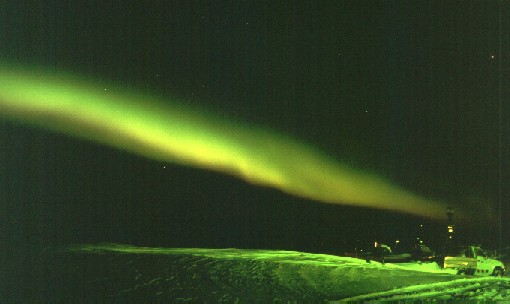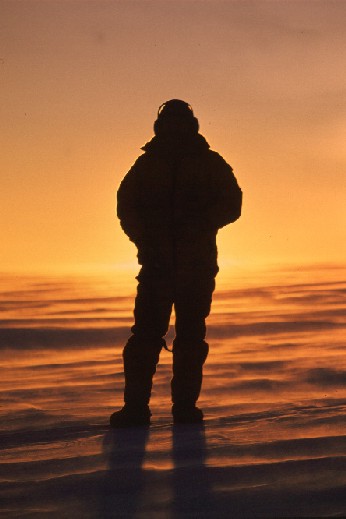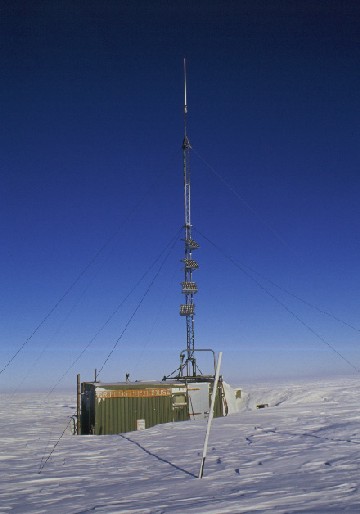A Trip to Blyth Junction after Mid-Winter
On the fun front, I'm starting to wind back up to speed after the winter lull. We had the best aurora seen, last week. We've had better, but clouded out. I had noticed the magnetic data going crazy all day and made a prediction on the mess white board. First nightwas clouded out, but I had predicted two nights running. So rubbed out two and out one night. It's a big competition forecasting. The weather people gets lots of stick when they predict fine andthere is a blizz. I haven't been proven wrong on my aurora forecast yet, as the ones I got wrong were clouded out anyway. Next morning I pull out an ancient graph with lots of wiggly lines and shack my head saying, look what we missed.It was looking bad, as I checked often till 10pm and not even a slight glow. A slight smudge is quite common, but very uninteresting to look at. I was about to go to bed, but went down stairs for one last look. It was like a squashed down rainbow from east to west. A single arch of bright lime green, very even, with an edge of pink underneath. It immediately started moving all over the place forming the more common multiple curtains, and twisted shapes.

A nice aurora looking out from the front of the Red Shed, Casey.
I wasn't sure what to do. A few people hadn't seen a descent aurora yet, but I couldn't remember who. I was sure Psycho wanted to see one so tried to ring him, but his phone was busy. So decided to not bother and rushed for my camera. At the last moment I woke up Mark and asked him to get Psycho. I must have made a lot of noise, lots of wowing etc, as a few others woke up (it was 11.30pm).
It lasted about 30 minutes, and twisted all over the place. The colour was the most amazing thing, since till then I'd only seen one withany real colour. Plus the way it moved all over the place so quickly. Most of the time you could see the vertical curtain shape as the particles steam down the field lines, having more and more collisions, thus getting much brighter at the bottom. Finally, if they have enough energy, they hit some layer (hydroxyl?) that gives off red light when ionized, thus the pink. It really does move fast. Most of the light is from above 100km. A bright patch above the west horizon can move across to the west in 10 seconds, like a big green fire ball.
Of course I had the slowest film in my camera (velvia asa 50). I've developed a roll that had a few shots on it, and two look great, just like the real thing. I have some special 1600asa film, but because I'd never use the whole roll at once, and its not very good for anything else, I don't put it in the camera.
In the same batch of film was a star trail shot that I'd forgotten about. I have an ASP work camera, a Canon something flash. It was a job lot with the auroral imager optics. We have two very wide angle lenses, and I've been playing with the one not on the experiment, an 8mm 180 degree fish-eye. I've got some really weird shots of people and buildings.
One night while doing my monthly magnetic absolute measurements, I set it up pointing at the azimuth, and left the shutter open for an hour and a half. It's hard to get away from the light pollution of the station, but the mag abs hut is on a small hill out the back, and I put the camera in the shadow of the hut. I couldn't believe itwhen an aurora came up !! I was sure it would wash out the photo, but worse that the field would go active and ruin my measurements. I do them after midnight, because that's when the field is least active. But it turned out great !! The stars rotate at a point almost in the center, the lights of Casey show up wonderfully, defining the horizon, and above the horizon is a narrow bandof green aurora over the station ! Couldn't have planned that one.
The other big event was my trip to Blyth Junction. Blyth is one of two VHF repeater stations servicing Dome Summit South, the ice core drilling project (which runs over summer), on the Law Ice Dome. The problem is that everything on the Plateau gets buried in snow. The hut at Blyth, called Griffo's Road House, was going under fast. Plus it never worked very well as a repeater as its in a hollow (very hard to tell unless you have an altimeter). The ice core drilling buildings are also being buried, and are also being crushed. Not much life left in them I'm told (hope to get there myself soon). There is an old American hut not far from Blyth, called S2 (S1 is on the edge of the plateau near Casey). It's now 15 meter below the surface, and can be reached by ladders down a hole.

We left very early from Casey and stopped for a break soon after sunrise somewhere past Lanyon Junction. George looked very good with the sun behind him and the low drift lit by the sunrise.
So the plan was to go up and pull down the 10 meter tower on top of the hut. Another trip will go put the hut on a sled and bring it back to Casey, and then it can be put where most people want to go (probably S1).
I'd hoped to do tourist things on this trip, but bad weather delayed us. The HF (high frequency) antenna pointing that way blew down. We needed it for comms while on the plateau. It was decided to make a dash up drop the tower and get back as quickly as possible (I'll go on the third trip and do touristy things).

A picture of the Nodwell
We left at 7.30am in the Nodwell, towing a RMIT van to sleep in over night. A Nodwell is a huge tracked, over snow vehicle. It must come from the days of the American base, and all the traverses onto Law Dome. None of the other bases have one. It has a crane on the back, and the cabin is nice and spacious (but stinks of ATK). Notice the 44 gallon drum on the back of it in the photo, or in comparison to the D7 dozer.A RMIT van is also a piece of history, I believe left over from when RMIT in Melbourne did Antarctic science. They are at all the bases,and we have two. The one we took was refitted in 1983 for a traverse, and was again refitted this year. They are very comfortable, with a gas stove, bunks, storage space, a couple of small windows, and electrically wired. So take a generator (gen set), and it has all the comforts of home.

A picture of the RMIT van
The Sunday we left was looking very grey. But if you wait till good weather nothing happens here. So we set off, and the cloud starts clearing wonderfully. Just a bit too well, as though being pushed by something, maybe a Katabatic ? Just as we were going through the morain gap, reaching the start of the plateau, a cloud low down formed in front of us. It's hard to gauge size and distance in those types of conditions. No reference. Its common to see localized cloud like this. It's caused by the cold heavy wind rushing off the plateau, and pressure change and picked up snow causes a cloud. It sometimes looks like water flowing down a hill.
So we drove from blue skies into almost white out. George had to change to GPS as I couldn't see canes in a few places. But surprisingly there wasn't much wind. Then as suddenly as it came, we drove out of it to blue sky again. Soon the sun started to come up and in front and behind us turned orange. We had a great view south of us, and the huge ice cliffs along the front of the Vanderford and Adams Glaciers (40 to 60 km away) shone in the early sunlight. I wish I hadn't taken my binoculars out of my pack! You could also see the cloud we had traveled through below us, hanging over Casey. I must have just been an inversion layer that caused condensation. Just when you think you understand the weather here, it does something different.
Now it was just a long haul traveling the 70km to Blyth at an average speed of 15km over rough (but not too bad) sastrugi. It was my first time traveling in the Nodwell, so the novelty kept me amused. Big Nose (Andrew) was keen to drive, and gave George a rest. To steer there are two levers to control the tracks. Pull a lever back and the drive on the track on that side is disengaged. Pull back further and brakes are applied to that track, making you go round in circles.

Griffo's Road House when it still had it's mast, and was at Blyth
Junction.
We got there at about 12.30pm. There is a keep left sign just short of Blyth which must be obeyed, or you run into the hut. I suppose you could go right??
We had hoped to use the crane to lower the mast in one piece and the pull it apart. But it was too short. I'd thought I was along to do tower work, but Big Nose wanted to go up. After lots of stuffing around he managed to get the gin pole attached so he could unbolt and lower to top section (it was made of 5 foot sections). It was bloody cold (but not really bloody cold), at -24degrees C. I got a bit of frost nip waiting around (it went away, very mild). Big Nose didn't look comfortable, always holding on with one hand, not trusting his harness.
We had a cuppa in the RMIT to warm up before finishing it. Big Nose asked if I'd like to do the rest. I wasn't going to hang around, and soon had the gin pole on the move. Trouble is its made of steel, and was top heavy. Even sitting on top of the tower I couldn't get above its center of gravity. What a stupid design! George was mucking around with the Nodwell and found he could get the crane higher if drove onto a small mound near the hut (actually it was the buried toilet). So all I had to do was get the gin pole down and the crane would do the rest. I got it down in a fashion, and no one was hurt.
I had to do a few more trips up and down to put on hooks and drop guy wires, and then we carefully lowered it. It had four expensive solar panels on the side we didn't want to damage.
By now it was clouded over again, and time for our radio sched with Casey. While Big Nose was laying out the HF antenna, George and I got stuck into the tower. We did a lot better then expected and had it apart and packed on the Nodie by 6.30.
The RMIT felt wonderfully warm, and I got stuck into making my usual jolly specialty, nachos. Two tins, cheese and corn chips. Three people, five things to wash up, the way to go in the field. By 8pm we were full and relaxed. George went out and checked the gen set. When he came in he asked if he should bring in the thermometer so it wouldn't fall off. I said it could wait till the morning. He said 'but we're going home now'. I thought they had been joking when it was mentioned earlier. But they wanted to show how good we were by getting home very early.
So reluctantly I got up and started preparing to leave. We soon had the gen set away and everything secure in the RMIT. We were on our way by 8.30.
We made good time on the way back (down hill??). The sky cleared again close to Casey, and we watched the thin crescent of the moon turn deep orange, become all distorted by the cold air layers over the ice, and set (it was almost straight when it disappeared). At the first VHF repeater at Lanyon Junction (which is on a rise), we saw the lights of Casey. We were home by 12.30am. To finish off the night there was a nice aurora to the north!!
Funnily enough, I slept in the next day!

Modern use of Griffo's Roadhouse, now located at S1.

